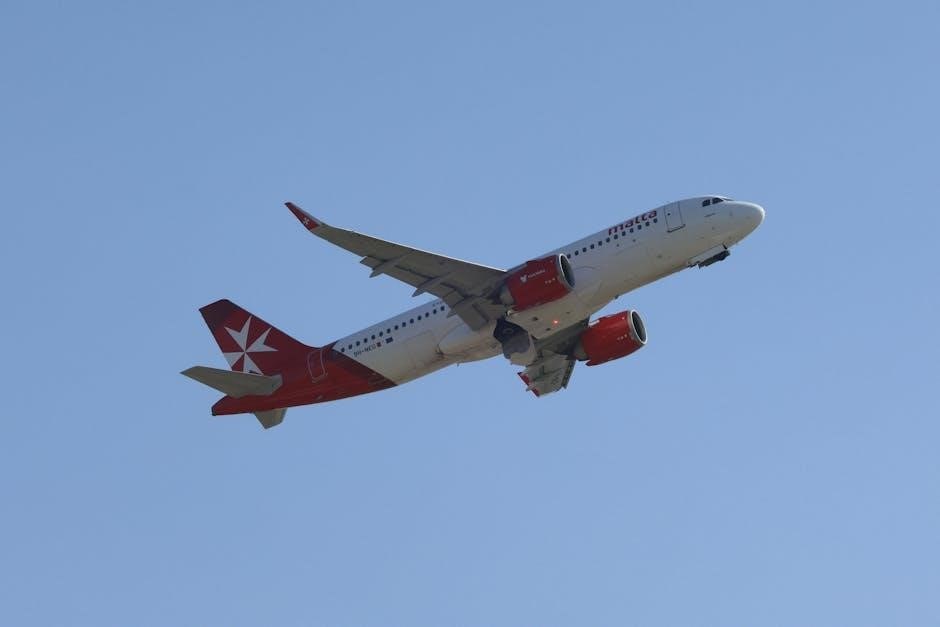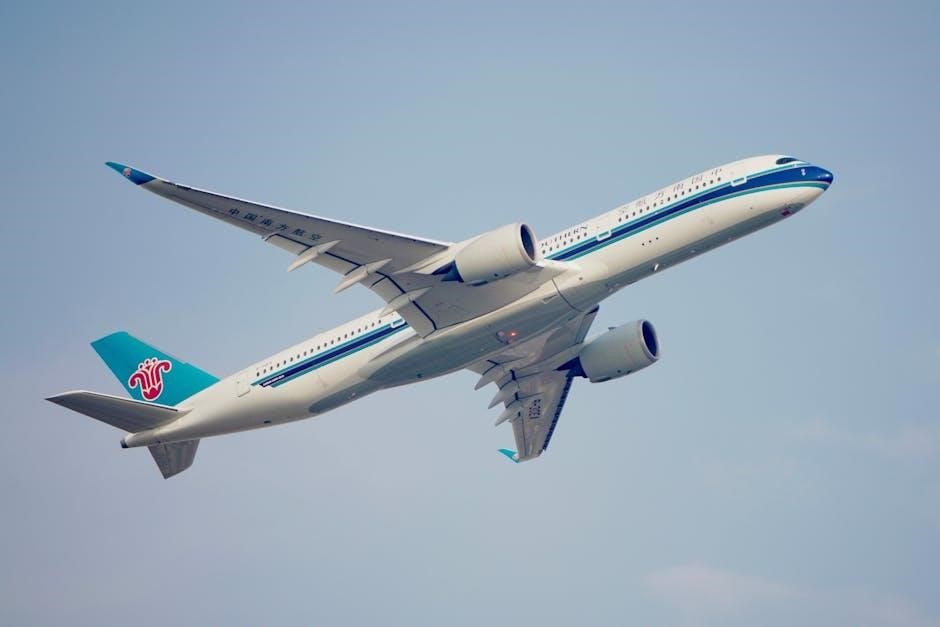Aircraft Flight Manuals
Aircraft Flight Manuals (AFM) are crucial for safe operations, detailing technical specifications, operating procedures, and emergency checklists. They ensure compliance with aviation regulations and guidelines, providing pilots with essential information for aircraft performance and safety. Digital formats enhance accessibility and efficiency in modern aviation practices.
1.1 Overview of Aircraft Flight Manuals (AFM)
An Aircraft Flight Manual (AFM) is a detailed document tailored for specific aircraft, providing critical operational information, performance data, and safety procedures. It includes limitations, normal and emergency procedures, and technical specifications. The AFM ensures compliance with aviation regulations and guides pilots in safe and efficient aircraft operation, adapting to both traditional and digital formats for enhanced accessibility.
1.2 Types of Flight Manuals (e.g., POH, AMM)
Various flight manuals cater to specific needs: the Pilot’s Operating Handbook (POH) details aircraft performance and operation, while the Aircraft Maintenance Manual (AMM) provides maintenance procedures. Additional resources include checklists and briefing cards, ensuring comprehensive guidance for pilots, maintenance crews, and operators, tailored to different aircraft models and operational requirements for safety and efficiency.
1.3 Electronic Flight Manuals (EFM)
Electronic Flight Manuals (EFM) streamline aviation operations by digitizing critical information. They offer real-time updates, enhanced search functionality, and reduced storage needs. EFMs improve accessibility, ensuring pilots and crews can quickly reference procedures, performance data, and safety protocols, thereby enhancing efficiency and compliance in modern aviation practices. Their digital format supports environmental sustainability and operational accuracy.
Aviation Safety Manuals
Aviation Safety Manuals are critical for ensuring operational safety, outlining procedures, emergency protocols, and compliance standards. They cover Safety Management Systems, checklists, and helicopter-specific guidelines to mitigate risks and enhance overall flight safety.
2.1 Safety Management Systems (SMS) in Aviation
A Safety Management System (SMS) is a systematic approach to managing safety, integrating risk management, safety policies, and continuous improvement. It ensures compliance with regulatory requirements and enhances aviation safety by identifying hazards, assessing risks, and implementing mitigation strategies. SMS is essential for fostering a safety culture and improving operational efficiency across all aviation sectors.
2.2 Emergency Procedures and Checklists
Emergency procedures and checklists are critical for ensuring safe operations during unexpected events. They provide step-by-step guidance for pilots and crew, covering system failures, medical emergencies, and evacuations. These standardized protocols, often included in Aircraft Flight Manuals (AFM), help reduce response times and enhance decision-making under pressure, minimizing risks and protecting lives. Digital formats improve accessibility and efficiency.
2.3 Helicopter Safety Management Systems
Helicopter Safety Management Systems (SMS) integrate safety policies, risk management, and compliance monitoring. They ensure proactive hazard identification and mitigation in rotorcraft operations. SMS frameworks, tailored for helicopters, enhance operational safety by standardizing procedures and promoting a safety-focused culture, critical for both commercial and private aviation environments. Regular audits and training reinforce their effectiveness in reducing incidents and accidents. Efficiency and safety are optimized through these systems.

Airport Infrastructure and Operations
Airport infrastructure encompasses planning, development, and maintenance of facilities to ensure efficient operations. It includes passenger data programs, air traffic control guidelines, and sustainable practices to enhance safety and efficiency.
3.1 Airport Planning and Development
Airport planning involves strategic development to meet growing demand, ensuring safety and efficiency. It includes designing infrastructure, optimizing layouts, and implementing sustainable practices to accommodate future growth while maintaining compliance with international aviation standards and regulations. Effective planning ensures airports can handle increasing passenger and cargo volumes efficiently.
3.2 Passenger Data Programs and Efficiency
Passenger data programs enhance airport operations by analyzing traveler behavior and preferences. These systems optimize resource allocation, streamline check-in processes, and improve security. By leveraging real-time data, airports can reduce congestion, enhance customer experience, and ensure efficient flow management, ultimately boosting overall operational performance and passenger satisfaction in a rapidly evolving aviation landscape.
3.3 Air Traffic Control (ATC) Guidelines
Air Traffic Control (ATC) guidelines ensure safe and efficient aircraft movement by providing clear communication protocols, routing strategies, and separation standards. These guidelines, often outlined by aviation authorities like the FAA, help controllers manage traffic flow, prevent collisions, and adapt to changing weather or operational conditions, ensuring seamless coordination between ground and air operations.

Pilot Training and Certification
Pilot training and certification involve initial licensing, instructor and evaluator training, and recurrent checks, ensuring adherence to Federal Aviation Regulations for safe, competent aircraft operations.
4.1 Initial Licensing and Training
Initial licensing and training involve comprehensive programs for new pilots, including ground school, flight training, and exams. Resources like the FAA’s Airplane Flying Handbook and Pilot’s Handbook of Aeronautical Knowledge guide students through aviation principles, weather, navigation, and regulations, ensuring a solid foundation for safe and competent flight operations from the start.
4.2 Instructor and Evaluator Training
Instructor and evaluator training focuses on developing expertise in teaching and assessing pilots. Programs include advanced aviation principles, instructional techniques, and evaluation methods. Resources like the Flight Instructor’s Manual and FAA testing standards guide instructors in delivering effective training, ensuring high-quality education and adherence to aviation safety and performance standards.
4.3 Recurrent Training and Proficiency Checks
Recurrent training ensures pilots maintain and enhance their skills through regular, standardized sessions. These sessions cover updated aviation regulations, safety protocols, and emergency procedures. Proficiency checks are conducted by certified evaluators to assess a pilot’s ability to operate safely and efficiently. Resources like digital libraries and recurrent training guides support these processes, ensuring compliance and competence.

Aviation Cybersecurity
Aviation cybersecurity focuses on protecting aircraft systems, passenger data, and infrastructure from cyber threats. Guidelines ensure secure operations, safeguarding sensitive information and maintaining compliance with industry standards.
5.1 Cybersecurity Guidelines for Aviation Operations
Aviation cybersecurity guidelines ensure protection of aircraft systems, passenger data, and infrastructure from cyber threats. These guidelines emphasize encryption, secure communication protocols, and regular system updates. The Aviation Cybersecurity Library provides detailed frameworks for compliance with international standards, ensuring operational safety and data integrity in the aviation sector.
5.2 Protecting Passenger Data and Systems
Protecting passenger data and systems is critical for maintaining privacy and security. Encryption, secure communication protocols, and compliance with regulations like GDPR are essential. Airlines must implement robust cybersecurity measures to safeguard sensitive information from breaches. Regular audits and employee training further enhance data protection, ensuring passenger trust and system integrity in aviation operations.

Maintenance and Engineering
Maintenance and engineering are critical for aviation safety, involving detailed manuals and procedures. Aircraft Maintenance Manuals (AMM) and engine guides ensure compliance, while historical archives preserve knowledge for modern practices.
6.1 Aircraft Maintenance Manuals (AMM)
Aircraft Maintenance Manuals (AMM) provide detailed instructions for inspecting, maintaining, and repairing aircraft systems. They ensure compliance with manufacturer standards and regulatory requirements, promoting safety and efficiency. AMMs are essential for technicians to perform routine and complex maintenance tasks effectively, covering everything from avionics to engine overhauls. They are available in digital formats for easy access and updates.
6.2 Engine and Avionics Maintenance Guides
Engine and Avionics Maintenance Guides offer step-by-step procedures for diagnosing and resolving issues. They cover troubleshooting techniques, repair protocols, and calibration processes, ensuring optimal performance. These guides are tailored to specific systems, providing detailed schematics and test procedures. Regular updates keep them aligned with technological advancements, enhancing reliability and safety in aviation operations.
6.3 Historical Archives of Maintenance Manuals
Historical archives preserve legacy maintenance manuals, offering insights into vintage aircraft systems. These records document original specifications, repair practices, and safety protocols. Archives serve as invaluable resources for historians, restorers, and researchers, ensuring the preservation of aviation heritage for future generations and educational purposes.
International Aviation Standards
International aviation standards ensure global harmonization of safety, security, and efficiency. Organizations like ICAO and IATA develop guidelines for operations, training, and infrastructure, fostering consistency across borders and enhancing aviation safety worldwide through standardized practices and regulations.
7.1 ICAO Manuals and Guidelines
ICAO manuals and guidelines provide standardized frameworks for global aviation safety, security, and efficiency. They include documents like the Convention on International Civil Aviation and annexes addressing aircraft operations, air traffic management, and environmental practices. These resources are essential for compliance with international regulations, ensuring harmonized aviation practices worldwide while addressing emerging challenges like COVID-19 risk management.
7.2 IATA Standards for Commercial Aviation
IATA standards and guidelines are designed to enhance safety, efficiency, and sustainability in commercial aviation. They cover a wide range of topics, including passenger services, cargo handling, and environmental practices. These standards are adopted globally, ensuring consistency and compliance across the industry while addressing emerging challenges and fostering innovation in aviation operations and management.
7.3 Regional Aviation Regulations (e.g., FAA, EASA)
Regional aviation regulations, such as those set by the FAA and EASA, ensure safety and compliance within their respective jurisdictions. These agencies establish guidelines for aircraft operations, maintenance, and pilot training, adapting global standards to regional needs while maintaining high safety levels and fostering collaboration across international borders to harmonize aviation practices effectively.
Digital Aviation Documentation
Digital aviation documentation streamlines compliance and efficiency, offering tools like Web Manuals for easy editing and distribution. Trusted by 700 aviation companies, it enhances accuracy and accessibility.
8.1 Web Manuals for Compliance and Efficiency
Web Manuals streamline aviation documentation, enhancing compliance and operational efficiency. They offer real-time collaboration, automated updates, and centralized access, ensuring all procedures are up-to-date and easily accessible. Integrated tools like compliance tracking and approval workflows simplify management, enabling aviation companies to maintain high standards while reducing administrative burdens. Trusted by over 700 aviation companies globally.
8.2 Digital Libraries and Resources
Digital libraries offer comprehensive collections of aviation manuals, guides, and historical archives. Platforms like Avialogs provide access to thousands of documents, from vintage aircraft manuals to modern technical specifications. These resources support pilots, researchers, and enthusiasts, preserving aviation history while enabling efficient access to critical information for safe and effective operations.
Future of Aviation Documentation
The future of aviation documentation lies in digital transformation and AI integration. Key trends include electronic documentation, AI-driven manuals, and real-time data analytics for enhanced efficiency and safety.
9.1 Trends in Electronic Documentation
The aviation industry is shifting toward electronic documentation, with tools like Web Manuals streamlining compliance and efficiency. Digital libraries and dynamic checklists enhance accessibility, while real-time updates ensure accuracy. This trend reduces reliance on paper, improving environmental sustainability and operational agility for airlines and operators worldwide.
9.2 Integration of AI in Aviation Manuals
AI is transforming aviation manuals by enabling predictive maintenance, real-time updates, and data-driven insights. Intelligent systems analyze performance data to optimize flight paths and safety protocols, ensuring compliance and reducing human error. AI-powered manuals enhance decision-making, offering personalized guidance for pilots and operators, thus improving efficiency and safety in aviation operations globally.
